Affiliate disclosure: This post may contain affiliate links. Please see our Privacy Policy.
Canning pears is a simple way to preserve pears for year-round use. It’s perfectly fine to can them with or without sugar, and in halves or slices based on your needs.
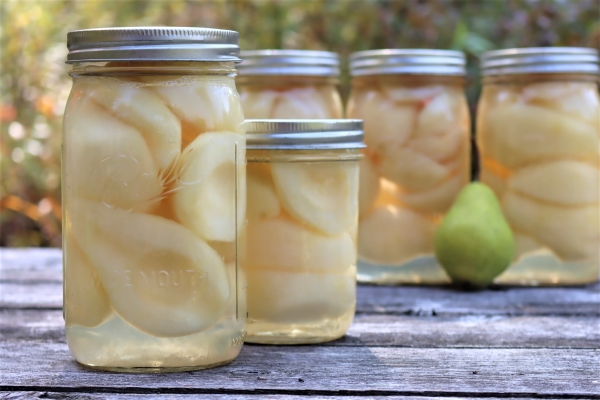
There’s a famous quote from Ralph Waldo Emmerson that says, “There are only 10 minutes in the life of a pear when it’s perfect to eat.”
That’s definitly an exaggeration, but in truth, peak pear ripeness lasts a few days at best. Sure, they ripen in the fall alongside all the hearty storage crops, but they’re usually short-lived. While they’re amazing in season, most varieties just don’t store well in the refrigerator or root cellar.
Canning pears is the perfect way to capture pears at the peak of ripeness. Home-canned pears maintain their flavor and texture better than just about any other fruit.
I really love making a pear version of the famous New York Times Plum Torte, taking canned pear halves out of the jar and nestling them right into the batter. It’s a beautiful presentation, and exceptionally delicious.
I make home-canned pears in both pints and quarts, the quarts for my baking, and the pints for my daughter. She’ll pop them open and eats them right out of the jar all winter long.
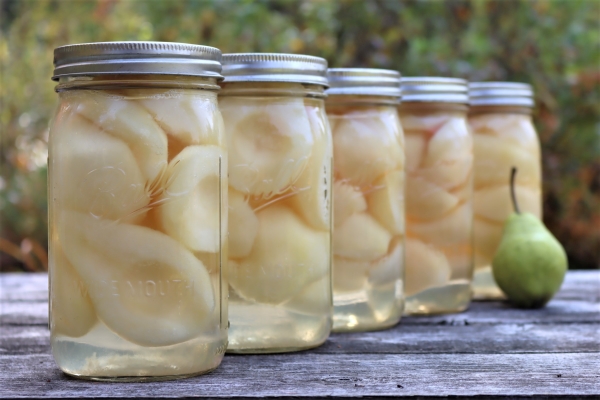
Best Pear Varieties for Canning
Most people say that Bartlett pears are the very best for canning…and I agree with them. They’re firm enough to hold up to cooking (without turning into bear sauce), but they’re soft enough that their texture before and after canning is pretty similar.
Bosc and seckel pears are also great for canning. If you happen to have a unique variety as a backyard tree, do a bit of research to determine if they’re good “canning pears” or if they’re better for sauce and pear butter.
(We also grow golden spice, ure, parker, and Cabot pears but I haven’t harvested enough of any of those varieties that they made it into the canning kitchen. Thus far, I’ve always canned bartlett and they don’t disappoint.)
Most European pear variety can be canned using this process, but be aware that Asian pear varieties are less acidic and need special consideration for canning (added acidity to the canning water). Here’s a primer on canning Asian pears, which come out wonderfully, but just require a bit of lemon juice for safe canning.
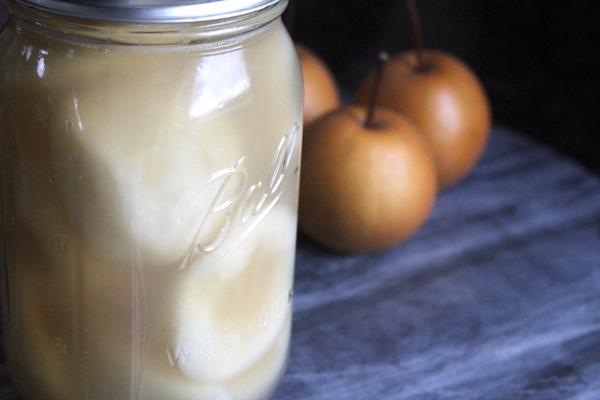
How Many Pears fit in a Canning Jar?
It takes a surprising amount of pears to fill a canning jar. A quart jar requires roughly 2 1/2 pounds of pears, which is roughly 5 whole average-sized pears. The ones we grow here in Vermont are often on the small side, meaning it’s 6-7 pears per jar left as halves.
If sliced, you’ll need a bit more to fill a quart since they pack a bit better. Plan on 2 1/2 to 3 pounds sliced, or 5-7 pears.
When canning in pints, you’ll fit just a smidge over a pound of pears per jar (especially in halves). As slices, plan for 1 1/4 pounds per pint (or 2 to 3 pears).
(All weights are in whole pears as they come off the tree, unpeeled and before prepping for canning.)
Syrup for Canning Pears
Pears can be canned in a variety of liquids, and plain water is a totally acceptable option. Fruit juices (apple, pear and grape) are also good options.
In my opinion, plain water canning washes out their flavor as they lose some sweetness to the canning liquid. Canning in fruit juice, unless you’re canning in pear juice, alters their flavor.
My favorite canning liquid is extra light syrup, which is roughly the same sweetness as the pears themselves. It doesn’t add sweetness, but simply maintains its natural fruit flavor. (Other sweeteners, such as honey and maple are also an option instead of cane sugar.)
The recipe for extra light syrup is as follows:
For a 7 quart canner batch ~ 10 1/2 cups water and 1 1/4 cups sugar
For a 9 pint canner batch ~ 6 1/2 cups water and 3/4 cups sugar
If you like sweeter canned pears, other syrup concentrations, from extra light all the way up to heavy syrup are safe for water bath canning. See this canning syrup table if you’d like the measurements for other syrup concentrations.
How to Can Pears
Canning pears starts with preparing the fruit. Peel the pears with a sharp paring knife, and then slice in half.
Since the flesh is relatively soft, it’s easiest to core the fruit with either a teaspoon or half teaspoon measuring spoon. A melon baller works well too, if you happen to have one of those on hand.
Slip the measuring spoon behind the core and scoop out a half-sphere of pear core.
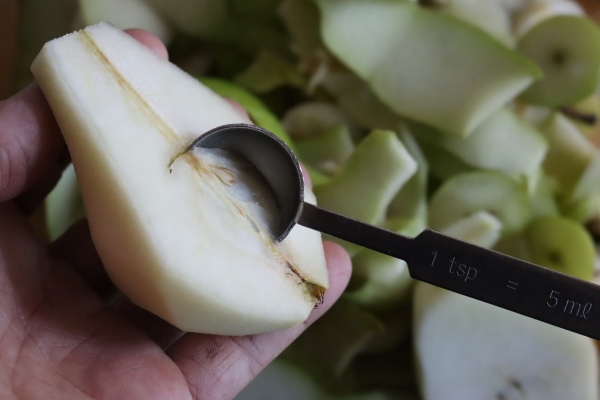
After the seed core, the center often has stringy material that’s not ideal for canning. Some pear varieties lack this, so you’ll have to use your best judgment.
This part is cosmetic but it will produce a higher quality canned pear. Slide that same measuring spoon up along the core, gently scraping out the remainder of the stringy core, and down to remove the blossom end.
When you’re done, the pear half should look like this…
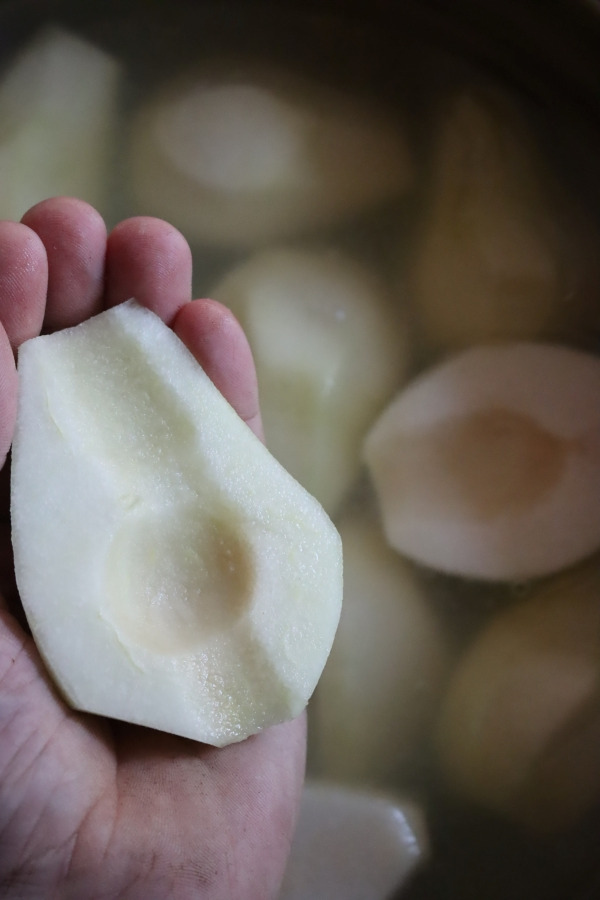
At this point, I chose to leave them as halves. Slicing the pears is an option too if you’re more interested in canning pear slices instead of halves. I can always slice them later, and canning pear halves leaves more flexibility.
Place the fruits into a bowl of cold water with a splash of lemon juice added. This will prevent them from browning while you peel the rest.
This is optional, but the fruit looks much nicer in the jar (and in baked goods later) if they don’t brown.
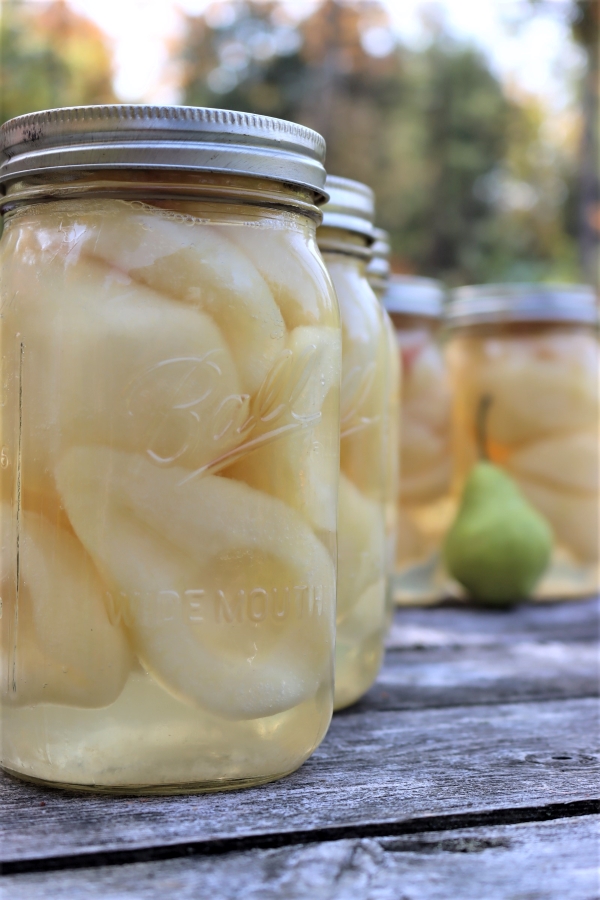
While you’re preparing the fruit, start heating a water bath canner.
In a separate pot, prepare a canning liquid. As mentioned above, you have plenty of choices when canning pears, and you can just use plain water. Fruit juice and light to heavy syrup are also allowed.
I use extra light syrup, which requires 10 1/2 cups of water and 1 1/4 cups sugar for a 7-quart canner batch (from about 17 1/2 pounds of pears).
Bring your canning liquid of choice to a boil, then strain the pears from the lemon juice water and add them to the boiling canning liquid.
Cook the pears for 5 minutes until they’re heated through, and then pack them into prepared canning jars (pints or quarts).
Seal the jars with 2 part canning lids and process in a water bath canner. Standard process times are 20 minutes for pints and 25 minutes for quarts below 1,000 feet in elevation. For higher elevations, see the notes below.
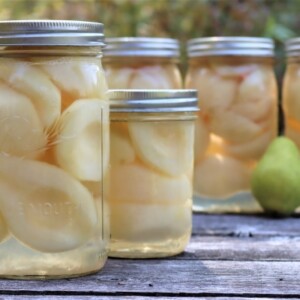
Canning Pears
Ingredients
- 17 to 18 pounds pears, roughly 30 to 35 pears
- Canning Syrup, Juice or Water *see note
- Lemon Juice, Optional, to prevent browning
Instructions
- Prepare a water bath canner.
- Peel and halve pears.
- Core pears, using a small measuring spoon to scoop out the core.
- Slice if desired, or leave as halves.
- Place prepared pears in a bowl of cool water with a splash of lemon juice added to prevent browning while you work.
- Once pears are prepared, bring a pot with the canning liquid of your choice to a boil on the stove (see note on canning liquids).
- Add the pears and cook for 5 minutes, until the pears are fully heated through.
- Pack the pears into canning jars leaving 1/2 inch headspace. Ladle canning liquid over the top of the fruits maintaining a 1/2 inch headspace.
- De-bubble jars, do any final headspace adjustments, and then cap with 2 part canning lids.
- Process the jars in a water bath canner for 20 minutes for pints and 25 minutes for quarts. (Recipe is written for a 7-quart canner batch below 1000 feet in elevation, see notes for other batch sizes and elevations.)
- Once the canning time is complete, remove the jars to cool on a towel on the counter. After 24 hours, check seals and store any unsealed jars in the refrigerator for immediate use.
- Sealed jars of properly canned pears should maintain peak quality in the pantry at room temperature for 12-18 months.
Notes
Nutrition
Nutrition information is automatically calculated, so should only be used as an approximation.
Ways to Preserve Pears
Looking for more ways to put up pears this season?
Fall Canning Recipes
Keep your canner going with these tasty fall canning recipes!
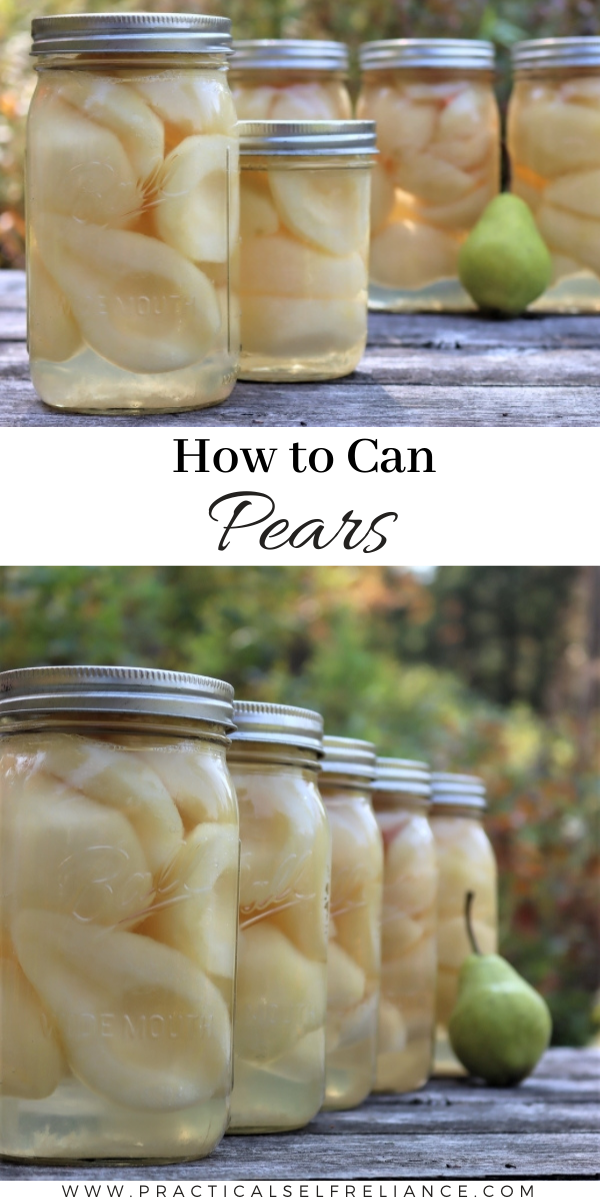
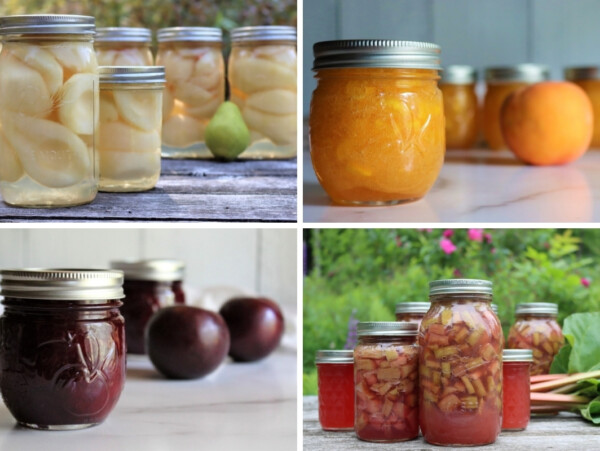
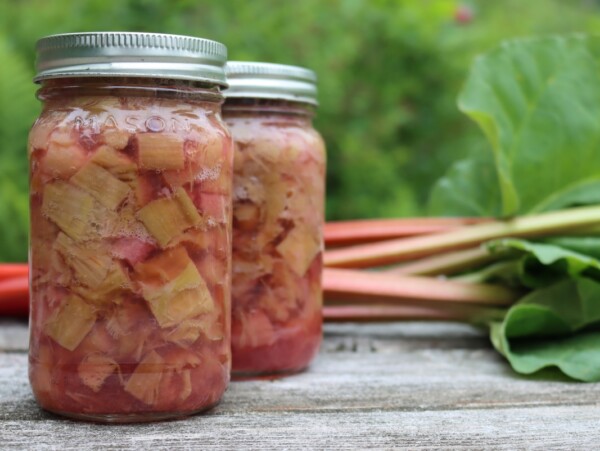
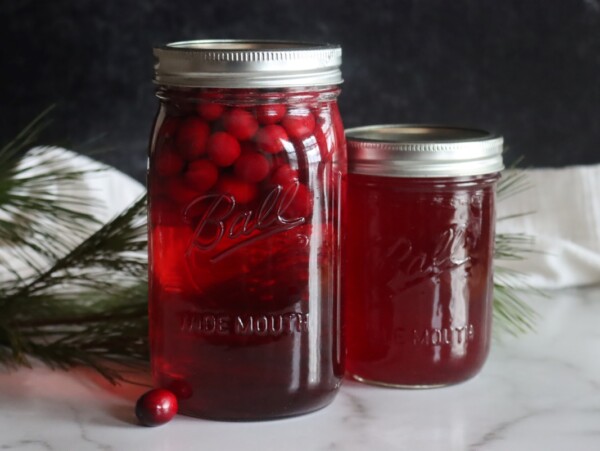
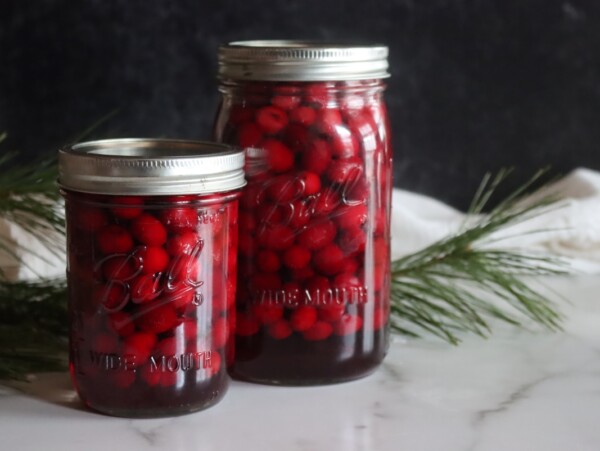










Do you ever freeze pears in the simple syrup if so what is the process thanks
I don’t usually freeze fruits, as we’re off grid and have limited freezer space, so canning and shelf stable storage make more sense for us. However, there are some really great instructions put out by the University of Georgia Extension here: https://nchfp.uga.edu/how/freeze/fruits/freezing-pears/
Question? Not about the canning of pears but what’s your thoughts on steam canning vs Waterbath? I’ve done little research and I can use my pressure canner as a steam canner obviously for water bath things only I’m not a rebel canner. Its less water less time waiting on the water to boil. Just an opinion is what I’m asking.i appreciate your canning recipes and your knowledge. Thanks
Steam canning is perfectly fine and safe, and is a great alternative to water bathing. I actually hadn’t done much myself, but it was promoted so heavily at the master food preserver training I went to earlier this year that I’m starting to do it more and more.
Perfect canned pears. I just added cinnamon sticks to my syrup.
Great idea!
Thank you for these guidelines! I don’t even know how many canning recipes of yours I’ve used, but now when I’m able to obtain bulk produce, I instantly think to check your website to see if you have a recipe/guidelines. Thank you for all of your hard work to help us newbies!
So glad it’s helpful to you Alex! I have a new canning specific website too, with even more recipes at CreativeCanning.com.
Can I raw pack the pears without cooking them first?
I am not aware of any tested recipes for raw pack pears since the quality for pears is usually pretty poor with a raw pack method.
Can I juice pears and use that as my canning liquid? I have both Asian and regular pears. Since Asian are juicer could I juice those to use as the canning liquid for my regular pears? Trying to avoid adding any extra sugar to my canning liquids.
Yes, you can use juice to can the pears. If you’re using Asian pears then you will want to add lemon juice since Asian pears are a low acid fruit unlike European pears.
I did mine in a pressure cooker because I thought that the low acid would be an issue and used plain filter water and the water turned pink what went wrong and are they safe to eat?
The higher temperatures of pressure canning can cause this discoloration which is why water bath canning is recommended. The good news is that as long as you followed approved processing times, the pears should be totally safe to eat.
Same happened to me! It looks like raw chicken, but my son still loves them and gobbles them up regardless of appearance.
I would like to know if you can do pears like peaches in open kettle instead of a canner.
Can you clarify what you mean by an open kettle instead of a canner? Are you talking about water bath canning?
I use Asian pears for canning and they have worked out beautifully.. our tree produces so much fruit it breaks the limbs off. I cab as much as I want then in it’d the neighbored to come pick pears. I use fruit protective instead of lemon juice to keep my pears from turning dark. It works great. I have been canning for over 60 years. Started out with my mother when I was very young. Love this site.
Wonderful, glad it’s working so well for you! (And canning for over 60 years is an amazing accomplishment, I hope I can say that for myself one day!)
Are you using a canner or hot water boil? Like you do jelly
These are processed in a water bath canner which is the same procedure for canning jelly.
I’m excited to try this out ! It’s my first time and I had a few questions. Do the pears need to be soft to can them or are you able to can them at any stage ? Also can I just use a regular big pot to boil the jars as long as they are covered ? What does debubbling mean? How do you know if your jars are sealed properly ?
You want them to be ripe but not overly ripe. If they aren’t ripe then you won’t get a good flavor. You can use a regular pot to process the jars but you want to be sure to put something on the bottom of the pot for the jars to sit on so that they aren’t directly sitting on the bottom of the pan. A dish towel will work for this or you can even use canning rings. Debubbling is the process of moving any air bubbles from the jar after filling. If you are new to canning I would recommend that you read this post which should answer any other questions that you might have. https://practicalselfreliance.com/water-bath-canning-beginners/
This is new to me and I am Unsure about extra light syrup. Can you send me the one that you use?
The recipe for extra light syrup is in the post. For a 7 quart canner batch ~ 10 1/2 cups water and 1 1/4 cups sugar
For a 9 pint canner batch ~ 6 1/2 cups water and 3/4 cups sugar.
Thank you so much for guiding me through the canning process. This was my first effort at it and my pears turned out perfectly!
Greetings from the pantry of Bear River, Nova Scotia, Canada
Nadya, Jeff and Flicka
You’re very welcome. I am so glad to hear that.
Thank you for the advice on canning pears. The idea of using a melon baller was fantastic. It worked perfectly for cutting out the core and any imperfections without losing a lot of pear.
I did double the light syrup recipe to be certain I had enough liquid to cover all the pears in the pot. Figured it was better to have extra than not enough to fill the jars.
Any advice on how to keep the syrup clearer when topping off the jars?
I’m not sure what you mean by keeping the syrup clearer?
This is my first time canning Bartlett pears from our trees. I was told to pick them before they were fully ripe because they will ripen from the inside out if left on the tree. Should I pick them before they ripen and then can them when they soften?
Thanks for the help?
Yes, that sounds like a perfect plan.
Thanks for the explanation of why you use extra-light syrup for pear canning. I used plain water the first (and only, thus far) time I’ve canned pears, and the flavor was washed out, although still moderately tasty. I had been trying to avoid excess sugar. Your explanation makes so much sense, and that’s what I will do next time.
Wonderful, so glad I could help!
Great info . . . . Lots of Options!! We canned 11 qts and a pint and they are beautiful! Love the light syrup, thank you!!
You’re very welcome. We’re so glad you enjoyed the recipe.
Can you leave the pear skins on and process them in halves or quarters?
Also I tried your no pectin grape and kiwi jelly recipes and they taste great but do have a softer set. Wondering if that is normal for no pectin added recipes?
Thanks!
Yes, you can leave the skins on if you like.
The no pectin grape jam is a looser set than many jams, but the kiwi jam recipe on this site is quite thick. It really depends on the recipe. Blackberry jam thickens beautifully without pectin as does blackcurrant jelly, and those have a nice firm set. Others are loser, it just depends on how much pectin is in the fruit to begin with. There’s some pretty good pictures of the thickness of the Grape jam on a spoon, and that’s pretty much how it turns out…a tad bit lose, but not excessively so.
Thanks so much! My family LOVES the kiwi jelly… it was something I was reluctant to try but am so glad you made it so easy! I think the pears are next on the list. I can still remember eating my grandmother’s… crossing my fingers!
love your simply telling and sharing information.